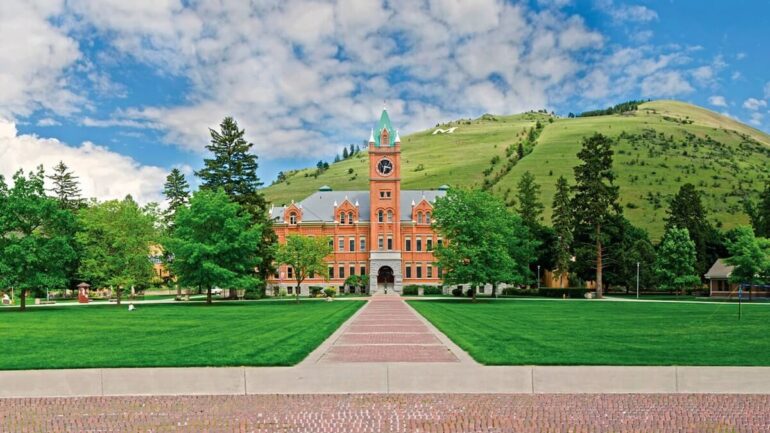TL;DR:
- The University of Montana has formed a cooperative research agreement with the Naval Undersea Warfare Center.
- The agreement enables access to U.S. Department of Defense funding opportunities.
- Key areas of collaboration include monitoring coastal dynamics in the Arctic and developing remote-sensing and AI applications for environmental assessment.
- This is the first formal agreement between UM and the Navy, highlighting UM’s growing reputation in environmental research.
- UM researchers gain access to the Navy’s advanced laboratories and test facilities.
- UM students will benefit from research opportunities and advanced training in environmental sensors and data science.
- The agreement aligns UM’s expertise with the needs of the Navy and federal agencies.
- UM researchers may receive multiyear project awards worth millions of dollars annually.
- The agreement strengthens UM’s research productivity and R1 university ranking.
- UM’s Numerical Terradynamic Simulation Group (NTSG) serves as the coordinating center for research activities.
- Global experts may be recruited to form specialized research teams.
Main AI News:
The University of Montana’s recent collaboration with the Naval Undersea Warfare Center in Keyport, Washington, marks a significant milestone in the realm of cooperative research. This groundbreaking agreement not only fosters a strong alliance between the two institutions but also opens up avenues for substantial funding opportunities provided by the U.S. Department of Defense, with grants ranging from $500,000 to a staggering $10 million.
Under this newly established partnership, both parties have identified several key areas for collaborative exploration. Primarily, they aim to enhance the monitoring and modeling of coastal dynamics and land-ocean-atmosphere interactions in the Arctic, a crucial undertaking in light of environmental changes in the region. Additionally, the agreement seeks to drive the development of cutting-edge remote-sensing applications for environmental monitoring, as well as the advancement of artificial intelligence and machine-learning applications for swift environmental assessments.
Professor John Kimball, a distinguished member of the forestry department and director of UM’s Numerical Terradynamic Simulation Group, expressed his enthusiasm regarding the agreement. He noted, “As far as I’m aware, this is the first formal cooperative agreement ever established between UM and the Navy.” This milestone serves as a testament to UM’s burgeoning reputation as a prominent leader in the field of environmental research and education.
The collaboration promises a multitude of benefits, including unparalleled access for UM researchers to the Navy’s state-of-the-art chemistry and sensor laboratories, as well as its comprehensive test facilities. Moreover, UM students will now have the opportunity to engage in groundbreaking research, immersing themselves in advanced data science, cyber research, and computer science development, all of which align with the research and development objectives of the Department of Defense and the Navy.
Kimball highlighted the manifold advantages this agreement presents for students, stating, “These include new research and funding opportunities and advanced training in the development and use of environmental sensors, remote sensing, AI, and machine-learning methods for data processing.” This collaboration firmly establishes UM as an institution equipped to meet the demands of the Navy and other federal agencies, as its research expertise and educational resources align seamlessly with their requirements.
The agreement holds the promise of multiyear project awards, with funding potentially amounting to tens of millions of dollars annually. This infusion of resources is expected to bolster UM’s research productivity and innovation, solidifying its status as a renowned R1 university. Through the collaborative efforts of the Naval Undersea Warfare Center and UM’s Numerical Terradynamic Simulation Group (NTSG), which operates as a UM Research Center of Excellence in alignment with the W.A. Franke College of Forestry & Conservation, the stage is set for breakthroughs in satellite remote sensing and Earth system science.
As the designated point-of-contact and coordinating center for UM’s research activities conducted under this agreement, NTSG will play a pivotal role in driving the collaboration forward. Additionally, the University may seek to recruit experts from around the world to assemble diverse and proficient research teams capable of tackling various projects.
Conlcusion:
The cooperative research agreement between the University of Montana and the Naval Undersea Warfare Center signifies a significant development in the market. This collaboration opens up substantial funding opportunities from the U.S. Department of Defense, ranging from $500,000 to $10 million, which can fuel innovation and drive market growth in the fields of coastal dynamics, remote sensing applications, and artificial intelligence. With UM’s growing reputation as a national leader in environmental research and education, this partnership showcases the market potential for advanced data science, cyber research, and computer science development.
Additionally, the access to state-of-the-art laboratories and test facilities, along with the recruitment of global experts, further enhances the market’s competitiveness and positions it as a hub for cutting-edge research and development in the environmental sector. Overall, this collaboration has the potential to foster market advancements, drive technological innovation, and solidify the University’s market position as a renowned research institution.

